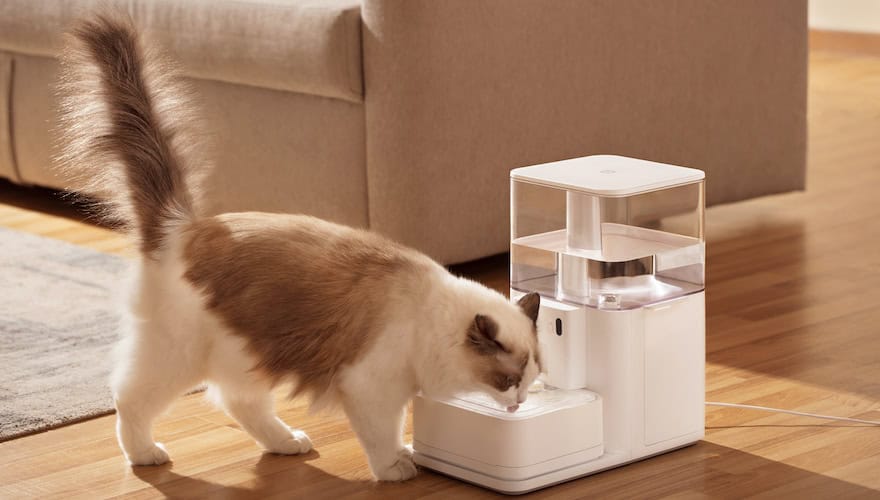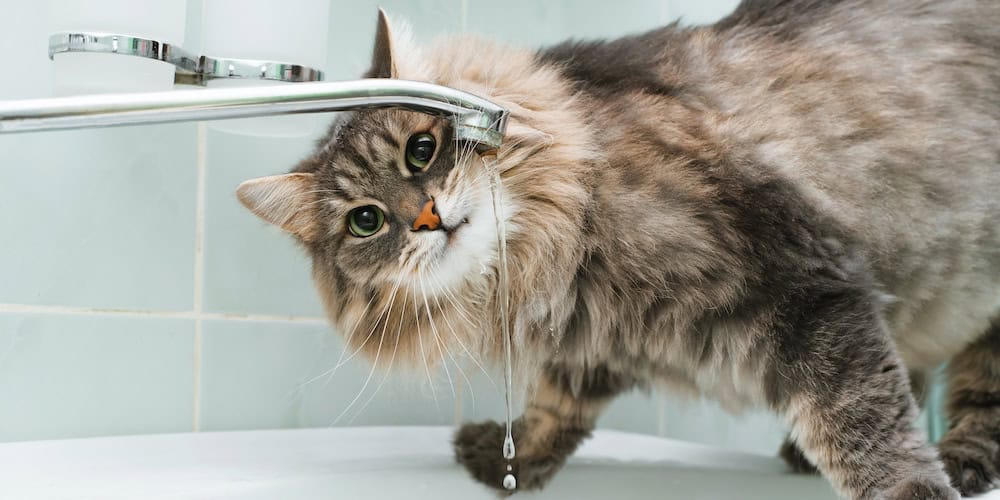“My cat drinks a lot!” or “He drinks more than usual” are quite common reasons for veterinary visits.
Outdoor living, presence of multiple water sources… The lifestyle of cats makes it very difficult to notice when they drink more than usual.
When an animal drinks more than usual, it’s called polydipsia. This term is defined as an increase in water consumption that exceeds the normal daily quantity.
Several causes can lead to polydipsia in cats, such as a disease like diabetes or hyperthyroidism.
Whatever the cause of polydipsia, identifying its origin enables the implementation of an appropriate treatment. Therefore, I encourage you to contact your veterinarian if your little feline experiences this.
In any case, I also recommend always providing several points of fresh water for your cat.
📚 Read also | A veterinarian has selected the best cat kibbles according to 3 criteria
How much water for a cat?
Cats’ water needs
A cat drinks, on average, 50 mL of water per kg per day. This means that a 5 kg cat drinks, normally, about 250 mL of water per day.
Nonetheless, I draw your attention to the link between water consumption and diet. Indeed, if your cat has a wet diet (cans or homemade meals), the amount of water drunk is less because their food already contains water.
On the other hand, if your cat eats only kibbles, these are low in water. Therefore, your cat’s daily water consumption is about the value mentioned previously.
How to know how much water my cat drinks
Unlike dogs, knowing how much water your cat drinks each day is no easy feat.
If your cat goes outside or lives outdoors, it has multiple water sources, making the task challenging.
However, if your cat lives strictly indoors, there are water fountains and dispensers that allow you to calculate how much water your cat drinks per day.
Additionally, keep in mind that some cats drink more than normal, especially kittens or pregnant and lactating females, due to their greater water needs.
What to do when my cat drinks a lot?
Detecting other symptoms
If you think your cat is drinking much more than usual, I recommend thoroughly observing for any other signs: Is their appetite altered? Do they have diarrhea?
Since we have seen that polydipsia and polyuria are often linked, also try to observe your cat’s urine. Are they clear or rather dark? Do you notice blood in their urine?
Generally, any sign or behavioral change should be reported to your veterinarian, in addition to polydipsia, to gather as much information as possible to find the correct diagnosis.
Scheduling an appointment with your veterinarian
You must have understood: a consultation with your veterinarian is necessary!
Additional tests need to be carried out to investigate the cause of polydipsia, including urine tests (dipstick and specific gravity measurement) or even blood tests.
Furthermore, some medications have diuretic effects, such as glucocorticoids. Do not forget to inform your veterinarian of any ongoing treatment to determine if this is not a side effect of the medication.

Why is my cat drinking a lot?
Polydipsia or polyuria
Often, polydipsia is accompanied by polyuria, meaning your cat urinates in a larger quantity.
Be careful not to confuse polyuria with urinary incontinence.
Polyuria and polydipsia are thus frequently linked, it’s referred to as polyuro-polydipsia (PUPD). And this is easily understood: either your cat drinks a lot and urinates more as a result; or they urinate a lot and therefore drink more to compensate for these water losses.
I therefore recommend observing your cat’s urination if you notice they are drinking more than usual.
From diabetes to kidney failure
Many diseases can lead to PUPD in cats. For instance, diabetes, or rather the various types of diabetes.
On one hand, diabetes mellitus, which is a disease where the glucose (sugar) level in the blood is higher than normal. Glucose is often present in the urine, called glucosuria. The kidneys eliminate more water to dilute this glucose present in the urine.
On the other hand, diabetes insipidus can also be a cause of PUPD. It is a condition where the filtration of water in the kidney is compromised. Water is not properly reabsorbed into the body, and a larger volume of urine is formed.
This list is by no means exhaustive and there are many other causes: renal failure, Addison’s disease, leptospirosis, etc.
A behavioral origin
Some dogs may suffer from potomania. This is a behavioral condition where dogs drink a lot of water compulsively.
However, potomania is not described in cats who do not seem to be affected. This study still raises the hypothesis of potomania in cats.
Sources and scientific studies
Dossier “Polyuria-polydipsia in dogs and cats”, Le Point Vétérinaire no. 391 of 12/01/2018, p. 27-44.
M. SCHMID Sarah, “A Stepwise Diagnostic Approach to Polyuria and Polydipsia“, Today’s Veterinary Practice, Internal Medicine, 10/17/2023



